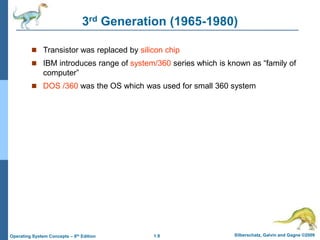Ch1 introduction-to-os
- 1. 1.1 Silberschatz, Galvin and Gagne ©2009 Operating System Concepts – 8th Edition Ch1: Introduction to OS (12M)
- 2. 1.2 Silberschatz, Galvin and Gagne ©2009 Operating System Concepts – 8th Edition What is an Operating System? A program that acts as an intermediary between a user of a computer and the computer hardware Operating system goals: Execute user programs and make solving user problems easier Make the computer system convenient to use Use the computer hardware in an efficient manner
- 3. 1.3 Silberschatz, Galvin and Gagne ©2009 Operating System Concepts – 8th Edition Four Components of a Computer System
- 4. 1.4 Silberschatz, Galvin and Gagne ©2009 Operating System Concepts – 8th Edition Four Components of a Computer System Hardware : It is basic computing device e.g. CPU memory Application Program : It defines a way in which resources are used to solve computing problem OS : It controls and co ordinate the use of h/w among application program User : who uses system
- 5. 1.5 Silberschatz, Galvin and Gagne ©2009 Operating System Concepts – 8th Edition Evolution and generation The evolutions of Operating System Batch Processing Multiprogramming Time Sharing Concurrent Programming Personal Computing Distributed Systems
- 6. 1.6 Silberschatz, Galvin and Gagne ©2009 Operating System Concepts – 8th Edition Evolution and generation There are four generation of Computer system 1st Generation (1945-1950) 2nd Generation (1955-1965) 3rd Generation (1965-1980) 4th Generation (1980-1990)
- 7. 1.7 Silberschatz, Galvin and Gagne ©2009 Operating System Concepts – 8th Edition 1st Generation (1945-1950) Mechanical part replaced by electrical Faster than mechanical Developed by Von Neumann and William Mauchely Make use of vacuum tube Due to vacuum tube occupies large space and produces heat Uses assembly language and no OS for this generation
- 8. 1.8 Silberschatz, Galvin and Gagne ©2009 Operating System Concepts – 8th Edition 2nd Generation (1955-1965) Vacuum tube part replaced by transistor Due to transistor large size and heat both problems were resolved Perform single job at a time Transistor leak some current
- 9. 1.9 Silberschatz, Galvin and Gagne ©2009 Operating System Concepts – 8th Edition 3rd Generation (1965-1980) Transistor was replaced by silicon chip IBM introduces range of system/360 series which is known as “family of computer” DOS /360 was the OS which was used for small 360 system
- 10. 1.10 Silberschatz, Galvin and Gagne ©2009 Operating System Concepts – 8th Edition 4th Generation (1980-1990) LSI IC’s are used Thousands of transistor s can be mounted on single chip
- 11. 1.11 Silberschatz, Galvin and Gagne ©2009 Operating System Concepts – 8th Edition Mainframe systems Batch Multi Programmed Multitasking Time sharing Desktop
- 12. 1.12 Silberschatz, Galvin and Gagne ©2009 Operating System Concepts – 8th Edition Batch To speed up processing, operators batched together jobs with similar needs and ran them through the computer as a group. Thus, the programmers would leave their programs with the operator. The operator would sort programs into batches with similar requirements and, as the computer became available ,would run each batch
- 13. 1.13 Silberschatz, Galvin and Gagne ©2009 Operating System Concepts – 8th Edition Multi Programmed Multiprogramming increases CPU utilization by organizing jobs so that the CPU always has one to execute. The operating system keeps several jobs in memory simultaneously As long as at least one job needs to execute, the CPU is never idle provided an environment where the various system resources were utilized effectively it did not provide user interaction with the computer system
- 14. 1.14 Silberschatz, Galvin and Gagne ©2009 Operating System Concepts – 8th Edition Multitasking (time sharing) All the previous system utilizes resources effectively but doesn't provide user interaction Time sharing (or multitasking) is a logical extension of multiprogramming The CPU executes multiple jobs by switching among them, but the switches occur so frequently that the users can interact with each program while it is running. the response time should be short typically within 1 second or so A time-shared operating system allows many users to share the computer simultaneously
- 15. 1.15 Silberschatz, Galvin and Gagne ©2009 Operating System Concepts – 8th Edition Clustered Systems Like multiprocessor systems, but multiple systems working together Usually sharing storage via a storage-area network (SAN) Provides a high-availability service which survives failures Asymmetric clustering has one machine in hot-standby mode Symmetric clustering has multiple nodes running applications, monitoring each other Some clusters are for high-performance computing (HPC) Applications must be written to use parallelization
- 16. 1.16 Silberschatz, Galvin and Gagne ©2009 Operating System Concepts – 8th Edition End of Chapter 1
















